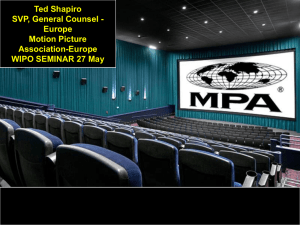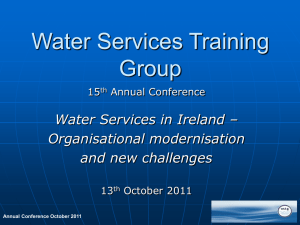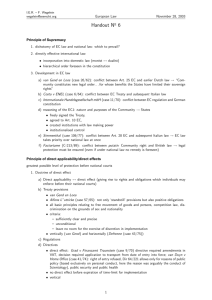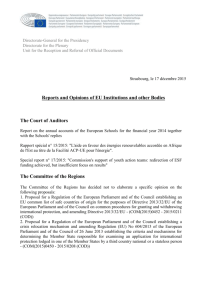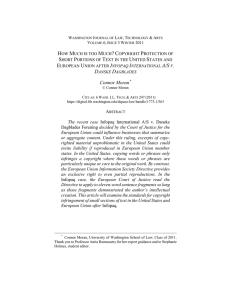to view slides - Competition Law Association
advertisement
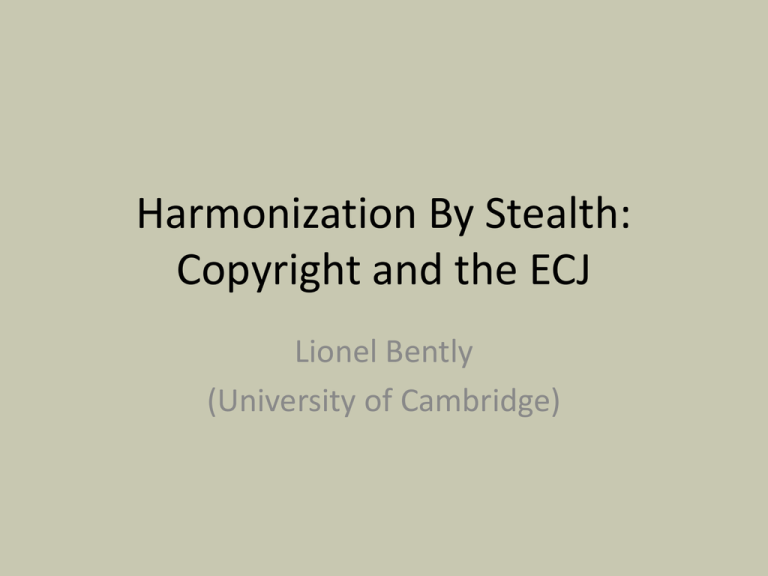
Harmonization By Stealth: Copyright and the ECJ Lionel Bently (University of Cambridge) Outline • The Political Limits of Harmonization • The ECJ’s Case-Law Extending Harmonization Beyond What Was Agreed • Is This Harmonization “By Stealth”? - Techniques • Even if it is By Stealth Should We Welcome It? - Advantages - Criticisms and Disadvantages The Limits of Harmonization • In contrast to trade mark law, where single “approximation” Directive, it was not thought possible or necessary to have full harmonization • Thus 6 vertical directives (Computer Programs, Rental Right, Satellite and Cable, Term, Databases, Resale Royalty Right), and 1 horizontal (Information Society, dealing with some rights, exceptions and some other matters) • Or so we thought…. The ECJ’s Case-Law Extending Copyright • • • • Originality The Work Ownership Designs Example 1: Originality • Commission Staff Working Paper on the Review of the EC Legal Framework in the field of copyright SEC(2004)995, 14: • “Up to now, the notion of originality has not been addressed in Community legislation in a systematic manner…On these occasions, the Community legislator has considered it necessary to take account of the special features or the special technical nature of the category of work in question. These special cases aside, Member states remain free to determine what level of originality a work must possess for granting it copyright protection…” Case C-5/08 Infopaq Int v Danske Dagblades Forening (2009) (4th Ch) • [37]: copyright within the meaning of Article 2(a) of Directive 2001/29 is liable to apply only in relation to a subject-matter which is original in the sense that it is its author’s own intellectual creation. • [45]…words …considered in isolation, are not as such an intellectual creation of the author who employs them. It is only through the choice, sequence and combination of those words that the author may express his creativity in an original manner and achieve a result which is an intellectual creation. Case 393/09, Bezpečnostní softwarová asociace, (22 Dec 2010) • when considering whether a “graphic user interface” was protected by copyright under 2001/29, the Court states (at [48]): • [48] When making that assessment, the national court must take account, inter alia, of the specific arrangement or configuration of all the components which form part of the graphic user interface in order to determine which meet the criterion of originality. Case C-604/10 Football Dataco Ltd and Others v Yahoo! UK Ltd and Others (1 March 2012) • discussing the criterion of originality for copyright under the Database Directive, 96/9, the ECJ stated at [38] • • [38] As regards the setting up of a database, that criterion of originality is satisfied when, through the selection or arrangement of the data which it contains, its author expresses his creative ability in an original manner by making free and creative choices (see, by analogy, Infopaq International, paragraph 45; Bezpečnostní softwarová asociace, paragraph 50; and Painer, paragraph 89) and thus stamps his ‘personal touch’ (Painer, paragraph 92). Example 2: The Work • Explicit harmonization in “vertical” Directives: computer programs (eg include preparatory design material); databases; neighbouring rights • Nothing else. Case C-393/09, Bezpečnostní softwarová asociace (2010) (3rd Ch) • 45 The Court has held that copyright within the meaning of Directive 2001/29 is liable to apply only in relation to a subject-matter which is original in the sense that it is its author’s own intellectual creation... • 46 Consequently, the graphic user interface can, as a work, be protected by copyright if it is its author’s own intellectual creation. • 47 It is for the national court to ascertain whether that is the case in the dispute before it. Case C-403/08, FAPL, (2011, Gr Ch) 96 FAPL cannot claim copyright in the Premier League matches themselves, as they cannot be classified as works. 97 To be so classified, the subject-matter concerned would have to be original in the sense that it is its author’s own intellectual creation (see, to this effect, Case C-5/08 Infopaq International [2009] ECR I-6569, paragraph 37). 98 However, sporting events cannot be regarded as intellectual creations classifiable as works within the meaning of the Copyright Directive. That applies in particular to football matches, which are subject to rules of the game, leaving no room for creative freedom for the purposes of copyright. 99 Accordingly, those events cannot be protected under copyright. Example 3: Copyright in Designs • Designs Directive, art 17 • ‘[a] design protected by a design right registered in or in respect of a Member State in accordance with this Directive shall also be eligible for protection under the law of copyright of that State as from the date on which the design was created or fixed in any form. The extent to which, and the conditions under which, such a protection is conferred, including the level of originality required, shall be determined by each Member State’ Example 3: Case C-168/09 Flos SpA v Semeraro Casa (ECJ, 2d Ch) (Jan 27, 2011) • 39 Nor does the fact that the Member States are entitled to determine the extent of copyright protection and the conditions under which it is conferred affect the term of that protection, since the term has already been harmonised at European Union level by Directive 93/98. • 34 However, it is conceivable that copyright protection for works which may be unregistered designs could arise under other directives concerning copyright, in particular Directive 2001/29, if the conditions for that directive’s application are met, a matter which falls to be determined by the national court. The ramifications of Case C-168/09 Flos • Contrary to implications of Art 17: (i) If design is registered, the “extent” of protection by copyright which is left to national law does not include term (ii) If unregistered, must protection as original work under 2001/29 if AOIC (iii) Presumably, such protection must comply with Arts 2-4, and exceptions must fall within the closed list in Art 5 (iv) But what about 2001/29 (saving for design rights) Example 4: Initial Ownership • [Picture removed due to Copyright] Case C-277/10 Martin Luksan v Petrus van der Let, (Feb 9, 20120 (ECJ, 3d Ch) • L, scriptwriter and principal director of a film entitled ‘Fotos von der Front’; VDL, producer • March 2008 ‘directing and authorship agreement’ involving partial assignment of copyright • VDL made available on the internet and assigned the rights for this purpose to Movieeurope.com. L sued • VDL relied on Austrian law that : • ‘The exploitation rights in commercially produced cinematographic works shall vest in the owner of the undertaking (film producer) … The author’s statutory rights to remuneration shall be shared equally by the film producer and the author, provided that they are not unwaivable and the film producer and the author have not agreed otherwise ...’ Case C-277/10 Martin Luksan v Petrus van der Let, (Feb 9, 20120 (ECJ, 3d Ch) • Various Directives give rights to author (Directive 2001/29, Arts 2, 3; Directive 2006/115, Art 3) • Various Directives designate principal director as author (Directive 2006/115, Art 2(2), Directive 2006/116, Art 2(1)) • [67] Since the status of author has been accorded to the principal director of a cinematographic work, it would prove incompatible with the aim pursued by Directive 2001/29 to accept that that creator be denied the exploitation rights at issue. Case C-277/10 Martin Luksan v Petrus van der Let, (Feb 9, 2012) (ECJ, 3d Ch) • [68] Refers to Article 17 of the Charter of Fundamental Rights (‘Intellectual property shall be protected’) • [69] ...the principal director of a cinematographic work must be regarded as having lawfully acquired, under European Union law, the right to own the intellectual property in that work. • [70] In those circumstances, the fact that national legislation denies him the exploitation rights at issue would be tantamount to depriving him of his lawfully acquired intellectual property right. Case C-277/10 Martin Luksan v Petrus van der Let, (Feb 9, 2012) (ECJ, 3d Ch) • Court goes on to indicate that rebuttable presumptions of transfer to producer are permissible • EU has such a rule in Art 2(5) of Directive 92/100 (now Art 3(4) of 2006/115) (and permits the rule to be extended to authors). Can MS’s operate similar rule? • Directive recognises balance between rights and interests of natural persons involved in intellectual creation and initiative, responsibility and risk of producer. Subsequent Directives retain concept. [78 ff, 84] • So Member States may operate presumption of transfer “provided that such a presumption is not an irrebuttable one precluding the principal director …from agreeing otherwise.” [87] Counter-Example: Declining to Deepen • Case C-283/10 Circul Globus Bucuresti (3rd Ch, 2011) • Did circus have to pay collecting society when it had agreement of authors? Was public performance harmonised in 2001/29? • [39] “the harmonization sought…is not intended to cover ‘conventional’ forms of communication to the public, such as the live presentation or performance of a work.” “Stealth”? The Reference system • ECJ does not set its own agenda. First requires national litigation and then decision by national court to refer. Moreover, national authorities make observations. • Insofar as the ECJ answers the questions referred, can we really accuse it of harmonization by stealth? • Where is the evidence that the ECJ has its own agenda rather that acting in accordance with legal rationality (or other influences)? Does the ECJ have an agenda? • Recent case-law has typically come from 3rd Chamber with Malenovský as rapporteur judge: SGAE, Padawan, Thuiskopie, Airfield, Painer, Circul Globus, Luksan, Football Dataco (except BSA(where he was present, but Arestis was rapporteur) • Many also have Lenaerts, von Danwitz, Silva • Infopaq (4th Ch, Malenovský), FAPL (Grand Ch), Flos, (2nd Ch, very different constitution, Lohmus) • But: variations in AGs : AG Trstenjak common (Infopaq, Painer, Padawan, Circul Globus, PPL v Ireland) but Bot (BSA, Flos, SAS), Kokott (FAPL), Jaaskinen (Thuiskopie, Airfield) Techniques • (1) Autonomous Meaning. If reference asks meaning of A, a European meaning in required unless there is express reference to national law: Case C-245/00 (2003) SENA v NOS. • (2) Dismissing other sources: eg Commission’s understanding. Case C-306/05, SGAE v Rafael Hotels, AG Sharpston [AG 45]. • (3) International ‘Law’: Case C-306/05, SGAE v Rafael Hotels, AG Sharpston: AG 34; Case C-5/08, Infopaq • (4) Systematic Interpretation. Assumption of Unity and Coherence of European Law. Case C-5/08, Infopaq. But also generalisation of old compromises: Luksan Technique 5: Rewriting the Question • Case C-393/09, Bezpečnostní softwarová asociace • [43] Nevertheless, even if the national court has limited its question to the interpretation of Article 1(2) of Directive 91/250, such a situation does not prevent the Court from providing the national court with all the elements of interpretation of European Union law which may enable it to rule on the case before it, whether or not reference is made thereto in the question referred … Technique 6: The Charter • Case C-277/10 Martin Luksan v Petrus van der Let, (Feb 9, 2012) (ECJ, 3d Ch) • Unnecessary to the decision. • Suggestive of broader principle: IPRs vest in creator and reallocation should be by presumptive rule only Other Explanations • No specific copyright agenda: a general tendency (well recognised in political science literature) of ECJ towards expanding its own role and deepening harmonization: supremacy, direct effect, preliminary ruling (Alter, ‘Who Are the Masters of the Treaty?’ (1998)) • Even without a harmonization agenda, just attempting to give the best answer, ie the one that fits best with the clearly-stated norms. Essentially, trying to be a good judge. The Implications of the ‘autonomous meaning doctrine’ • References to ‘authorship’ in Directive 2001/29, Arts 2, 3; Directive 2006/115, Art 3 • CJEU will need to define authorship, and presumably co-authorship (and in turn rights of co-authors) Could Luksan extend to “moral rights”? • (a) Moral rights are unharmonized (see eg 2006/116, Art 9, rec 20; 96/9, rec 28) • (b) So MS free to confer, or not, on who and howsoever they want? • (c) But all Member states are party to Berne, which has Art 6 Bis requiring recognition for authors • (d) Moreover International Covenant requires protection of “moral interests” • (e) And Database Directive Recital 29 recognises that: “belong to author” But can Art 17 be a basis for an objection to limitations on rights? • Case C-70/10 Scarlet Extended v SABAM (Nov 24, 2011) (ECJ, Third Ch): “The protection of the right to intellectual property is indeed enshrined in Article 17(2) of the Charter of Fundamental Rights of the European Union (‘the Charter’). There is, however, nothing whatsoever in the wording of that provision or in the Court’s caselaw to suggest that that right is inviolable and must for that reason be absolutely protected.” So better view, CDPA s. 79(3) and 82 can be maintained. Regulation of property for “general interest” not “deprivation” Advantage: Legitimate Outcomes, Overcoming Political Sensitivities • Legislative limits avoid political difficulties associated with harmonizing different copyright cultures of civil and common law • Recognised in Commission Staff Working Paper on the Review of the EC Legal Framework in the field of copyright SEC(2004)995, 14 in relation to ownership: – “One reason for the scarcity of…Community rules governing the initial ownership is the sensitivity of the issue and the fact that it is so closely associated with the foundations of copyright and the objectives of the copyright regime in a given country….” • ECJ seems prepared to grapple with these Disadvantage 1: Process Legitimacy (a) Between EU and MS: • Karen Alter (2000) 54 Int Org 489, 513: • “[T]he ECJ used legal lacunae to seize new powers and delve into areas that member states considered to be their own exclusive realm” (Alter 2000: 513) (b) Between Legislature and Judiciary Disadvantage 2: Transitional Uncertainty • What happens to existing copyright works post Infopaq? Removing copyright from sub-original works in UK, where no “unfair competition”? • What about the UK’s closed list after BSA? Now to be interpreted to encompass any “intellectual creation”? • Could Luksan render rules on ownership of crown copyright, registered designs, or even limiting moral rights of employees, illegitimate? • Designs: what about CDPA s. 51 and s. 52? What about the UDR interface?

